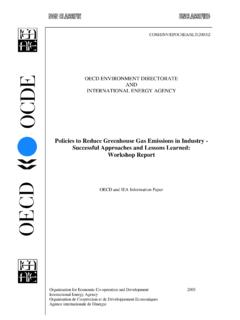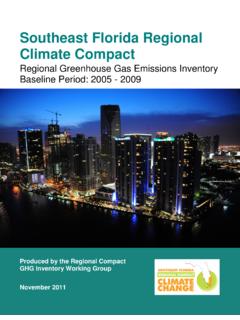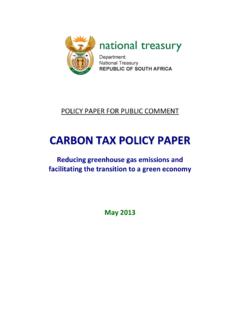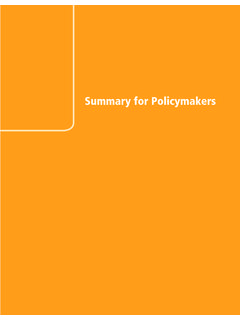Transcription of The Role of Non-CO2 Greenhouse Gases in Climate …
1 The Role of Non-CO2 Greenhouse Gases in Climate Change mitigation : Long-term scenarios for the 21st century Shilpa Rao* and Keywan Riahi*. Abstract The Non-CO2 Greenhouse Gases have so far jointly contributed around 40 percent to overall global warming. In this paper we examine the role of these Gases in meeting long-term Climate change targets. For this purpose, we develop mitigation scenarios aimed at achieving long-term stabilization of global radiative forcing at W/m2 as compared to pre-industrial times. We use the MESSAGE model for a thorough bottom-up representation of the various Greenhouse Gases and the corresponding mitigation technologies. This approach endogenizes energy feedback effects from mitigation of Non-CO2 Gases and takes into account the interplay and side benefits that exist across GHGs.
2 We analyze two mitigation scenarios - one allowing only for CO2. mitigation and another with multigas mitigation . In addition, we also investigate a lower stabilization level of 3 W/m2 and look into the implications this has for abatement strategies. Our approach helps us to identify a portfolio of measures in the energy, industry and agricultural sectors for achieving a proposed Climate target. We find that considering the full basket of GHGs improves the effectiveness of the mitigation portfolio resulting in significantly lower costs, especially in the short term. In the long run, the bulk of the emissions reductions are still seen to come from CO2 and this effect becomes more pronounced under the more stringent Climate target.
3 This emphasizes the importance of a diverse mitigation portfolio that includes both CO2. and Non-CO2 related abatement options in meeting long-term Climate targets. Energy Journal . International Institute for Applied Systems Analysis, Schlossplatz 1, A-2361 Laxenburg, Austria. Corresponding authors: 1. 2 / Energy Journal 1 Introduction The United Nations Framework Convention on Climate Change (UNFCCC) calls for the stabilization of Greenhouse gas (GHG) concentrations in the atmosphere at a level that would prevent dangerous anthropogenic interference with the Climate system. The Kyoto Protocol to the Convention commits its parties to binding targets based on as a basket' of six GHGs, including carbon-dioxide (CO2), methane (CH4), nitrous oxide (N2O), hydrofluorocarbons (HFCs), perfluorocarbons (PFCs), and sulfur hexafluoride (SF6).
4 Most studies dealing with Climate change, however, have almost exclusively focused on CO2, which remains the main anthropogenic contributor to Climate change. Even though Non-CO2 GHGs have so far only contributed around 40 percent to overall global warming (see IPCC 2001a), the interest in them is increasing. One reason for this is that the inclusion of Non-CO2 Gases and their various mitigation options are expected to improve the cost-effectiveness in realizing Climate targets (see Reilly et al. 2003). In this paper we study the role that Non-CO2 Gases might play in a long-term scenario which integrates a portfolio of mitigation measures for CO2 and Non-CO2 Gases alike.
5 While CO2 is mostly emitted from the energy sector, CH4 and N2O emissions are largely associated with activities in the industrial, agriculture and waste sectors. In the future, emissions from these sources are expected to grow, with the largest increases expected in developing countries. While population and economic growth are the main drivers for these emissions, changes in industrial processes, agricultural practices and waste management also play an important role. A number of effective and cheap mitigation options for different sources have been identified but their actual costs still remain uncertain. Some of them adversely affect food production and may involve substantive changes in traditional agricultural practices, thus making them difficult to implement, especially in developing countries.
6 In the context of these uncertainties, it becomes important to consolidate existing information on the Non-CO2 Gases and include it in developing long-term responses to Climate change. We employ a modeling approach that allows us to identify specific mitigation options for all the Kyoto Gases as well as endogenize energy feedbacks in the agriculture and industry sectors. We develop so called central' mitigation scenarios aimed at achieving long-term stabilization of global radiative forcing at W/m2 by 2100 as compared to pre-industrial times. This roughly corresponds to a global temperature change of degrees measured at median Climate sensitivity. We compare and contrast a scenario, which accounts for mitigation of CO2-only versus one that includes the full basket of GHGs.
7 We also examine scenarios based on an alternative radiative forcing target of about 3 W/m2 and the implications of such a lower stabilization level for multigas mitigation strategies. The remainder of the paper is structured as follows. Section 2 discusses the scenarios that we develop for this analysis. Section 3 is a detailed description of the main emission drivers and mitigation technologies. The scenario quantification and results are presented in Sections 4 and 5. respectively. Section 4 focuses on the central mitigation scenario aiming at the stabilization of radiative forcing relative to pre-industrial times at W/m2, and Section 5 gives a sensitivity analysis for a low stabilization target (3 W/m2), broadly consistent with a long-term temperature change of 2 C.
8 Section 6, summarizes our main conclusions. The Role of Non-CO2 Greenhouse Gases in Climate Change mitigation / 3. 2 Scenario Description The baseline used in this analysis is the B2 scenario derived from IPCC's Special Report on Emissions (SRES 2000; Nakicenovic (ed.) 2000). The B2 storyline has been well documented (Riahi and Roerhl 2000). It describes a world in which the main emphasis is on local solutions to economic, social and environmental sustainability. We develop three mitigation scenarios based on this baseline. Our central cases comprise a CO2-only scenario and a multigas scenario (including carbon sinks) aiming at the stabilization of radiative forcing at an intermediate level of about W/m2.
9 In addition, a sensitivity case explores multigas strategies for attaining a low stabilization target of about 3 W/m2. In the CO2-only central mitigation scenario, the system is constrained to meet a radiative forcing of W/m2 (in 2100 as compared to pre-industrial times) by reducing only fossil-fuel related CO2 emissions. We calculate the total carbon equivalent' of all GHGs from the CO2-only scenario (using 100-year GWPs 1 ) and apply this to the multigas scenario to obtain the same radiative forcing, but using all six GHGs. In addition, in the multigas scenario, mitigation from forest sinks is also included. We use MESSAGE (Messner and Strubegger 1995) as the basis for incorporating emission sources and mitigation options.
10 MESSAGE is a bottom-up systems engineering model based on a least cost optimization framework. The model maps the entire energy system with all its interdependencies from resource extraction, imports and exports, conversion, transport and distribution to end-use services. It is a long-term global model with a time horizon of a century (1990-2100). The main outputs of the model are primary energy and emissions of GHGs as well as local pollutants like SOX and NOX. For this analysis, MESSAGE was extended to cover all six Kyoto GHGs, their drivers and mitigation technologies. In addition, MESSAGE includes a simplified carbon cycle model for the estimation of atmospheric CO2 concentrations.







